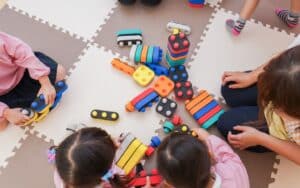Language is a fundamental aspect of human development, and the earlier we start fostering this skill in children, the better. One of the most effective methods to enhance child language development is through hands-on learning opportunities. In this article, we will explore the role of hands-on learning for child language development.
Why Hands-On Learning Is Essential
Hands-on learning involves direct engagement with people, objects, and situations that foster experiential knowledge. Hands-on learning supports language development in many ways including:
- Multi-sensory Stimulation: Engaging various senses makes language experiences more tangible and words and concepts more meaningful.
- Active Participation: Children are not passive recipients but active participants in their learning. They can explore, experiment, and practice as they learn.
- Real-world Application: It provides context to words and abstract language concepts, making them concrete.
How Hands-On Learning Works
At the heart of hands-on learning lies experiential knowledge. Experiential knowledge:
- Enhances Memory Retention: By making abstract concepts tangible, children recall and understand better.
- Promotes Active Participation: Instead of being mere spectators, children become active learners.
- Bridges Theory and Reality: It offers practical applications to theoretical knowledge.
Hands-On Learning Opportunities by Developmental Age

Infants (0-12 months)
- Touch & Feel Books: These textured books let babies feel different surfaces, helping parents describe sensations.
- Mirror Play: As the baby interacts with their reflection, parents can make and imitate actions, and talk about body parts and expressions.
- Soft Toy Interactions: Use plush animals to introduce animal names and sounds.
- Sensory Bottles: Fill transparent bottles with various items like glitter, beads, and water and secure them for safety. Explore them with your child. Describe the movement, sounds, and contents.
- Textured Play Mats: Enhance sensory experiences with mats of varying textures. Describe sensations like “rough,” “smooth,” or “squishy.”
Toddlers (1-3 years)
- Shape Sorters: While playing, reinforce shape names and properties.
- Simple Craft Activities: Crafting with large a variety of media, describing colors and counting.
- Nature Exploration: Collect leaves or stones and discuss their characteristics.
- Building Blocks: Describe sizes, colors, and actions as they stack and build.
- Interactive Storybooks: Explore, name items depicted, and describe books with flaps or touch-and-feel components.

Preschoolers (3-5 years)
- Role Play: Set up a mini marketplace or clinic, introducing relevant vocabulary.
- Kitchen Experiments: Mix baking soda and vinegar, discussing reactions.
- Themed Scavenger Hunts: Search for items that are soft, round, or blue.
- Puzzles: Use simple puzzles and scene puzzles where you can model, and children can be prompted to name and describe what they see.
- Gardening: Plant seeds and care for them. Discuss the growth process.

School-Age (6-12 years)
- Recipe Creation: Cook a dish together, introducing terms like “stir,” “pour,” or “blend.”
- DIY Art and Crafts: Create items and discuss tools, processes, components, and finished product.
- Board Games with a Twist: Play matching games, Scrabble or Pictionary, focusing on vocabulary.
- Journaling: Encourage child to draw or write daily, then discuss their entries.
- Science Projects: Build something like a volcano or a solar oven, introducing scientific terminology.
Teens (13-16 years)
- DIY Workshops: Engage in carpentry or sewing, learning technical terms.
- Book Clubs: Reading and discussing novels can expand vocabulary and analytical skills.
- Travel Journaling: Document trips or local visits, describing experiences in detail.
- Debate Clubs: Discuss topics, encouraging the use of persuasive language.
- Photography Projects: Describe scenes, emotions, and techniques in detail.
FAQs about Hands-On Learning
- Why is hands-on learning particularly effective for language development?
- Physical engagement helps children associate words with what they represent. This makes abstract words more understandable. When children touch, manipulate, explore or otherwise interact with an object, the associated vocabulary becomes more real and more memorable.
- How can I ensure safety during hands-on activities?
- Safety is a top priority. Always supervise activities, especially for younger children. Ensure materials are non-toxic, age/developmentally appropriate, and free from danger and choking hazard.
- Are there digital tools that can supplement hands-on learning?
- Yes, there are many educational apps and platforms that offer interactive learning experiences. While they don’t replace tactile learning, they can be a valuable addition.
- How can I adapt hands-on learning for children with special needs?
- It’s essential to tailor activities to the child’s needs. For instance, children with sensory sensitivities might benefit from adjusted or specialized materials. Always collaborate with specialists or therapists for tailored advice.
- Can older children and teenagers still benefit from hands-on learning?
- Definitely! While the activities might become more complex or sophisticated, the tactile and experiential component of hands-on learning remains beneficial throughout adolescence and even into adulthood.
Additional Resources
- The Importance of Hands-On Learning (thethinkingkid.org)
- The Importance Of Hands-On Learning For Young Children – Begin Learning
- UNICEF-Lego-Foundation-Learning-through-Play.pdf
- Language learning is hands-on: Exploring links between infants’ object manipulation and verbal input – ScienceDirect
- Zero to Three
- PBS Parents
- Hands On As We Grow
- Edutopia
- Learning 4 Kids
Summary/Conclusion
The journey of language development in children is a vibrant tapestry of words paired with experiences, interactions, and discoveries. Hands-on learning serves as a bridge, connecting the abstract world of words to the tangible realities of life. By consistently integrating tactile experiences into a child’s learning environment, we pave the way for deeper understanding, enhanced retention, and a lifelong love for language.




0 Comments